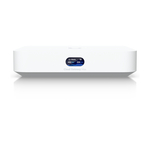Great prices on the Ubiquiti UCG Max, Dream Router 7 and Express 7.
Ubiquiti UniFi Cloud Gateway Max 2.5GbE router $483.
Specs
Quad-core ARM Cortex-A53 1.5GHz Processor.
3GB RAM.
Default WAN Ports: 1 x 2.5G Ethernet RJ45.
LAN Ports: 4 x 2.5G Ethernet RJ45.
IDS/IPS Throughput: 2.3Gbps.
Can run all the UniFi apps (Network, Protect, Access, Talk and Connect).
Built-in 512GB NVMe SSD for Protect (supports up to 2TB).
Note: Ubiquiti wireless access point(s) sold separately.
Ubiquiti UniFi Dream Router 7 $502.
Specs
Quad-core ARM Cortex-A53 1.5GHz Processor.
3GB RAM.
Default WAN Ports: 1 x 10G SFP+ and 1 x 2.5G Ethernet RJ45.
LAN Ports: 3 x 2.5G Ethernet RJ45 (1 x Ethernet RJ45 port has built-in PoE with a 15.4W maximum).
IDS/IPS Throughput: 2.3Gbps.
Wi-Fi 7 tri-band with 6GHz.
Coverage Area: 160m².
Can run all the UniFi apps (Network, Protect, Access, Talk and Connect).
Ubiquiti UniFi Express 7 Router $379.
Specs
Quad-core ARM Cortex-A53 1.5GHz Processor.
3GB RAM.
Default WAN Ports: 1 x 10G Ethernet RJ45.
LAN Ports: 1 x 2.5G Ethernet RJ45.
IDS/IPS Throughput: 2.3Gbps.
Wi-Fi 7 tri-band with 6GHz.
Coverage Area: 160m².
Only runs the UniFi Network app.
Surcharges: 0% for bank deposit, Afterpay & Zip Money. 1.2% for VISA / MasterCard & PayPal. 2.2% for AmEx.
Free shipping excludes WA, NT & remote areas.


If you're planning on getting the UCG-Max, you may as well pay a bit more for the UCG-Fiber